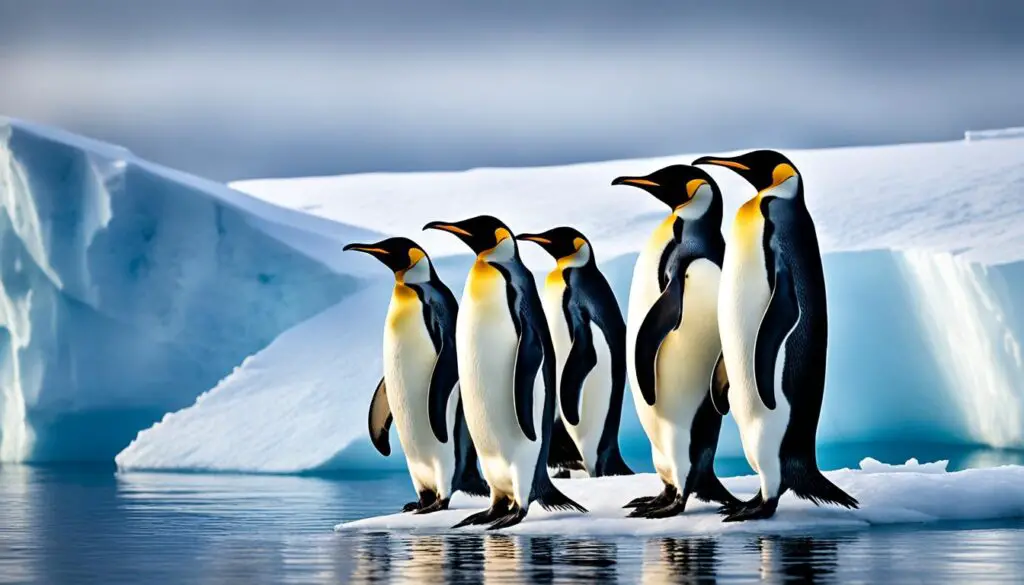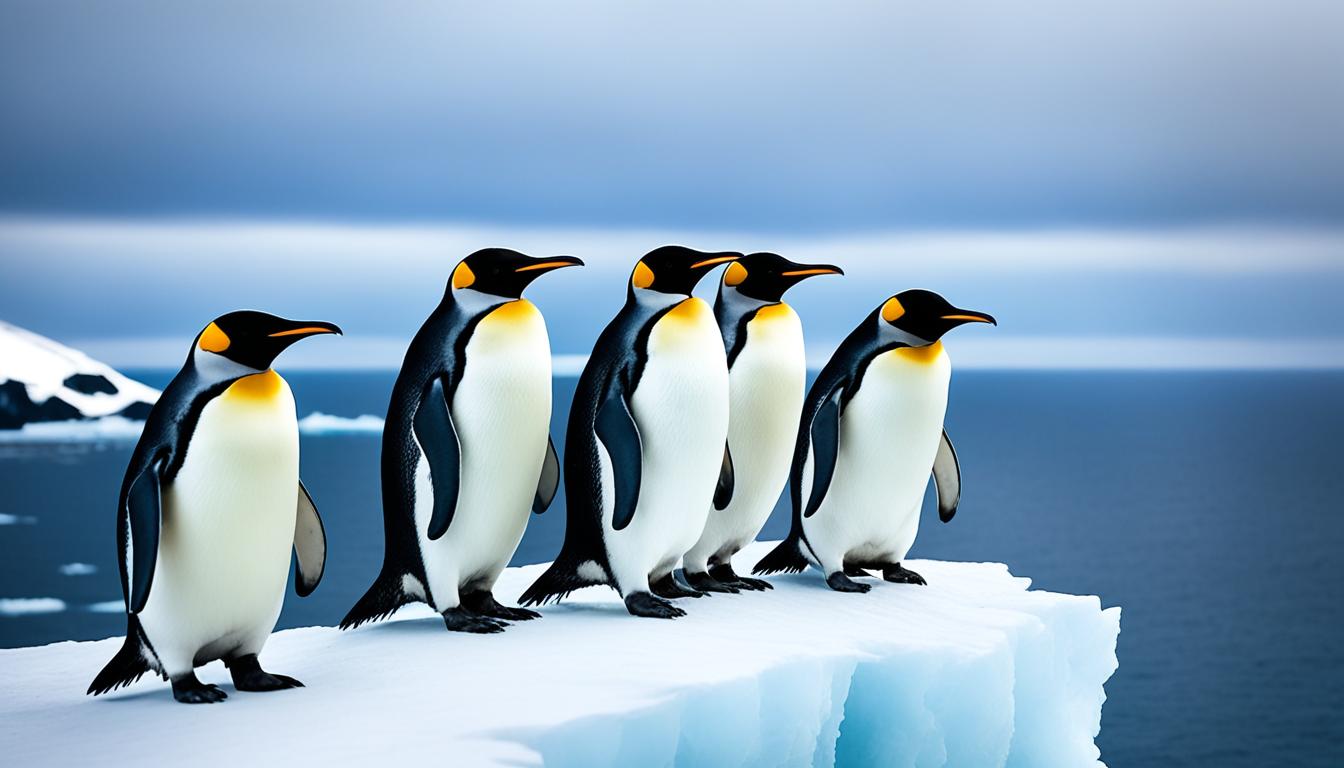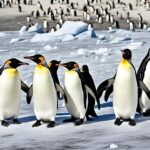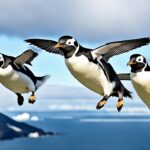Ever thought about the amazing journey of Antarctic penguins? These incredible birds have advanced ways to navigate their icy homes. Learning how they find their way shows their unique traits and their important role in nature. By looking into their natural skills and new technology, we can see how penguins use their own GPS. Get ready to explore how penguins navigate and what it means for their survival.
The Incredible Journey: Understanding Penguin Migration
Penguins’ migration journeys are truly fascinating. They show how different species adapt to harsh environments. The Emperor and Adelie penguins, for example, have unique migration patterns tied to their breeding and feeding needs.
Many things affect penguin migration, like ocean currents, ice, and food. Emperor penguins travel long distances, while Adelie penguins cover shorter paths but are very agile in their icy homes. These migrations are crucial for their survival, showing how closely their lives are linked to their environment.
Studying these migrations helps us understand penguins better. It also shows why we need to protect their homes. By learning how they adapt, we can help protect their habitats and ensure they can thrive in a changing world.
How do penguins navigate?
Penguins have amazing skills to cross vast oceans. They use a strong sense of direction to survive and reproduce. They have tools inside them to safely reach their goals.
Natural Navigation Skills Exhibited by Penguins
Penguins can sense the Earth’s magnetic field, which helps them navigate. They also use the sun’s position and the shape of the land to guide them. This makes it easier for them to find their way in open waters.
Factors Influencing Penguin Migration Patterns
Many things affect where penguins migrate. They go to certain places to breed. They follow currents with lots of fish to eat.
Changes in water temperature and ice also change their migration paths. These factors make their migrations complex.
Navigational Tools: Penguins’ Natural GPS
Penguins have amazing ways to navigate that help them survive. They use their magnetic field sensitivity and sun compass to find their way. These tools are key to their penguin navigation skills.
Internal Mechanisms: Magnetic Field Sensitivity
Penguins can feel the Earth’s magnetic field, which guides them across the ocean. This skill acts like a built-in GPS. It helps them stay on track, even in rough seas.
The Role of the Sun Compass in Navigation
Penguins also use the sun to help them navigate. They watch the sun’s position to know where they are going. This method is vital for their migrations, making their journey more precise.
Penguin Tracking Technology: Innovations in Research
New tech in penguin tracking has greatly improved our knowledge of how they move and behave. Using satellite tracking, scientists can track penguins in real-time during their migrations. This helps us learn about their paths and behaviors over long distances, making penguin studies more detailed.
Satellite Tracking Systems Revolutionizing Navigation Studies
Satellite tracking has changed how scientists watch over penguin populations. By putting small satellite tags on penguins, researchers can see where they go as they cross oceans. This tech gives us precise info on their migration times, distances, and what affects their trips. It has led to new discoveries about how these amazing birds navigate.
The Impact of Remote Cameras on Penguin Behavior Research
Remote cameras are key in studying penguins, letting scientists watch them without disturbing them. This way, we learn about their breeding, eating habits, and how they interact with each other. Projects like Penguin Watch let people help by looking at camera footage. This teamwork helps us understand how changes in the environment affect penguins, which helps with conservation efforts.
Environmental Influences: Climate Change and Navigation
Climate change is affecting penguin migration patterns. Changes in temperature and sea ice are altering their traditional paths. Food is key to their migration success, but warmer waters change fish and krill populations.
How Climate Change Affects Penguin Migration
Climate change is changing marine ecosystems, making life hard for penguins. Sea ice changes limit where penguins can breed and travel safely. Some penguins migrate earlier or later due to these changes.
This can lead to fewer penguins, which is bad for their species.
Human Activity and Its Effects on Penguin Movement
Humans greatly impact penguin navigation. Overfishing reduces their food, making them travel far for food. Pollution adds toxins to their homes, making migration harder.
These changes force penguins to change their paths, making them more vulnerable.
Penguin Foraging Behavior: Searching for Food
Penguins have amazing ways to find food that help them survive. They use their skills to find food sources important for living and having babies. Their methods show how they use their navigation to find what they need.
Feeding Patterns and Their Connection to Navigation
Penguins’ eating habits are closely tied to their environment. They pick certain patterns based on where they can find food and how they navigate. They use their inner compass and outside signs to track fish or krill, which are key to their diet. This way, they make the most of their time and energy while hunting.
How Penguins Use Landmarks to Forage Effectively
Penguins are very precise in finding food using landmarks. They use things like glaciers and the seafloor to guide them. This helps them find food faster and use less energy. Being able to spot and follow these signs is crucial for their survival in tough environments.

Citizen Science: Community Involvement in Penguin Research
Engaging in citizen science lets people help with penguin research. Projects like Penguin Watch let people join the scientific process. They help collect important data on penguin populations and behaviors. Through volunteering, we learn more about these amazing birds.
The Role of Projects like Penguin Watch in Data Collection
Citizen science works with the public to improve research. Projects like Penguin Watch are great for several reasons:
- They speed up the analysis of big data sets.
- They give researchers more observations.
- They make people more interested in ecological issues.
People who join Penguin Watch look at penguin pictures. They note their behaviors, where they nest, and threats to their homes. This helps gather important info and builds a community feeling. As more data comes in, we learn more about how the environment affects penguins.
The data from these projects helps conservation efforts. It helps researchers make better decisions about protecting penguin homes. In short, citizen science is key to understanding penguins better. You can join and help protect these amazing animals.
Conservation Implications: Protecting Penguin Navigation
Learning how penguins navigate is key for both research and saving these amazing birds. Knowing their migration paths helps us protect them better. It’s crucial to understand how climate change and human actions affect their ways.
This knowledge helps us make better conservation plans. Many penguins need certain paths for food and breeding. By protecting these paths, we can help save not just penguins, but their whole homes.
Protecting penguin navigation is vital for saving them. You can help by spreading the word about how climate change harms their ways. By understanding penguin migration, you can join the conversation on saving their future. This way, these birds can keep living in a world that’s always changing.










